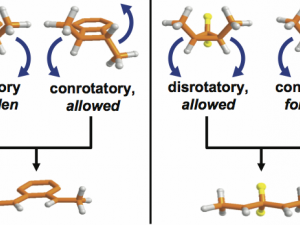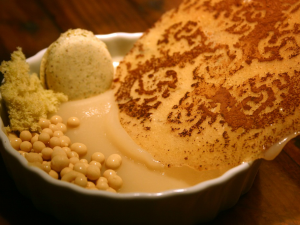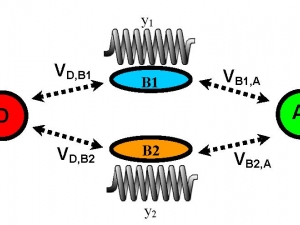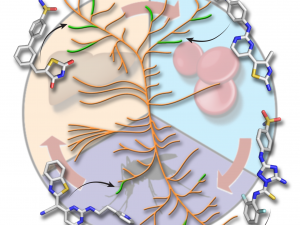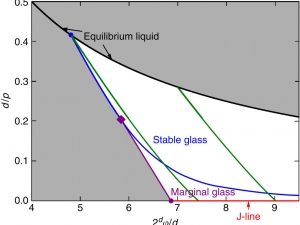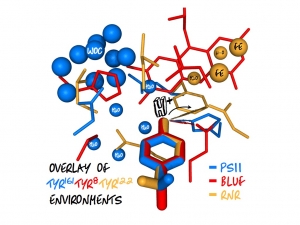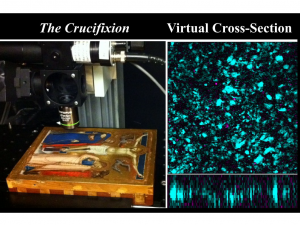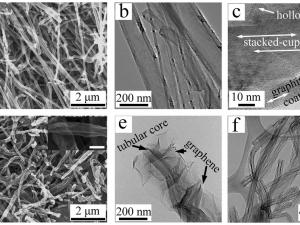The Fitzgerald group and their collaborators at the National Institute of Environmental Health Sciences find that house dust mite allergens are more thermodynamically stable and more abundant than non-allergens in the dust mite proteome. Read more about their discovery in Duke Today and also see their paper published in the Journal of Allergy and Clinical Immunology. read more about Fitzgerald Group Characterizes Dust Mite Allergens with SPROX Methodology »
Most solid materials are amorphous. Although the behavoir of these materials is anomalous when compared to crystalline solids, the origin of the difference has long been a source of confusion. The Charbonneau group and collaborators have recently found evidence for an exotic phase transition that might underlie the effect. The results appear in the Proceedings of the National Academy of Sciences, USA. read more about Gardner Gathers Glasses »
Professor Beratan’s group has just reported a new mechanism for spin-forbidden excitation energy transfer, a process of great significance in solar photochemistry. The group finds that spin forbidden electronic energy transfer, known as Dexter energy transfer, may be mediated by excited states of the bridge linking an electronically excited donor to an acceptor group (indicated by the blue and green squares in the diagram), rather than by charge-transfer states of the system (indicated by the gray and oranges… read more about Solar Photochemistry Breakthrough Reported by Beratan Group »
A theoretical-experiemental collaboration between David Beratan’s group at Duke University and Nongjian Tao’s group at Arizona State University has established and validated an approach to control the wave-like characteristics of electrons as they move through DNA. A paper just posted online at Nature Chemistry - and highlighted in a Duke News article - describes strategies to sustain coherent or wave-like DNA charge transport on the the length of multiple nanometers in soft-wet self-assembled matter. … read more about Beratan and Collaborators show how DNA sequences turn molecules into electron highways »
An article in Science by Prof. Agostino Migliore and collaborators reports the design of robust (opto)electronicmolecular switches. The experiments demonstrate reversible, stable and reproducible electrical switching of single molecules linked to graphene electrodes. The theoretical analysis reveals the chemical-physical underpinnings of photoinduced and temperature-dependent mechanisms for the observed switching. This work provides unambiguous evidence that molecules with suitable electronic properties and engineered… read more about Breakthrough in Nanoelectronics: Design of Robust Molecular Switches »
A recent article by Prof. Alvin Crumbliss in Nautilus focuses on the metallome, a collection of metal atoms that helped shape modern biology and impacted evolution. For more on how the metallome changed cellular chemistry, please see the article available here. read more about Crumbliss Rocks with Heavy Metal(s) »
Yuan Zhuang from the Charbonneau group has recently made a breakthrough in the description of periodic microphases. This advance enables the determination of phase diagrams for models that can form cluster crystals, double gyroid, lamellae, and other complex mesoscale assemblies. The results appear in Physical Review Letters. read more about Charbonneau Lab Makes Breakthrough in Periodic Microphases »
In a collaborative and highly interdisciplinary effort, the Wang, Warren, Malcolmson, Blum, and Theis labs have disclosed a new class of molecules that may be used as biomolecular tags for MRI, potentially enabling metabolic processes to be viewed in real time. The work, published in the journal Science Advances and highlighted in Duke Today, details the hyperpolarization of these molecules through an iridium-catalyzed spin-polarization transfer from singlet-state hydrogen gas, increasing NMR signals, which… read more about Interdisciplinary Efforts Lead to Imaging Tag for MRI »
Charbonneau and collaborators have recently made the stunning prediction that, upon cooling, simple glass-forming liquids can form two different types of amorphous solids. This work and the broader scientific context for this fundamental advance is featured this month in the French popular science magazine, La Recherche. A link to the article, though in French, may be found here: http://www.larecherche.fr/mensuel/510 read more about Charbonneau's Glass-Forming Liquids Featured in La Recherche »
The Hargrove lab discusses progress towards the molecular characterization of long noncoding RNAs (lncRNAs), a relatively new class of biomacromolecules implicated in a wide range of biological processes and human diseases. Despite the widely-recognized importance of lncRNAs, biochemical and biophysical studies are still in early stages. This Current Topics article in Biochemistry describes and analyzes the techniques currently in use to study the structure, interactions, and functions of lncRNAs as… read more about Connecting long noncoding RNA structures and biochemical functions to disease »
The Derbyshire Lab reports the discovery of inhibitors that target multiple stages of malaria parasite growth. To identify these inhibitors Derbyshire took advantage of the TCAMS small molecule library, which is comprised of diverse and potent chemical scaffolds with activities against malaria's blood stage and investigated their effects against malaria's elusive liver stage using a forward chemical screen. More on their recent developments may be found here in Antimibrobial Agents and Chemotherapy… read more about Derbyshire Lab Targets Malaria »
Researchers in the Franz lab have built a peptide that binds one kind of metal ion with greater ease if it binds a different type of metal ion first. This unique example of cooperative, heterometallic allostery in a biologically compatible construct suggests the possibility of designing conditionally active metal-binding agents that could respond to dynamic changes in cellular metal status. Read more here: http://pubs.rsc.org/en/content/articlelanding/2015/SC/C5SC00602C#!divAbstract read more about Bind One Get One Free »
A new review from the McCafferty lab focuses on KDM1 class lysine demethylases. These enzymes are integrally involved in many biological processes and diseases and are therefore promising therapeutic targets. The comprehensive review describes the unique structure and substrate specificity of these enzymes, as well as current efforts toward inhibitor development. It further explores the regulation of KDM1 function through the formation of multiprotein complexes. Read more here, in the special issue of Biopolymers… read more about Reviewing the Complex Worlds of Lysine Demethylation »
Researchers in the McCafferty Lab have recently designed a mutant enzyme that shows promise as a molecular probe. This engineered enzyme is a mutant of lysine–specific demethylase 1A (KDM1A/LSD1), an epigenetic target with therapeutic potential. The researchers removed a protein interaction domain from KDM1A and replaced it with the corresponding region of a closely related enzyme. This molecular tool will allow users to effectively study the protein–protein interactions of KDM1A. Read more here. read more about Uncoupling Protein–Protein Interactions from Enzyme Catalysis »
Duke chemists have used single molecule techniques to induce forbidden reactions and probe the structures of the associated transition states. Read more here. read more about A Glimpse Of The Forbidden »
Patrick Charbonneau hosts seminar in Paris to relate his experience teaching an introductory-level science class on melding chemistry and cuisine at Duke University. Contemporary chefs such as Ferran Adrià, Joan Roca, and Heston Blumenthal have more than fame in common. They use soft matter chemistry and physics to create a gastronomy that challenges the traditional culinary experience. Techniques are not followed blindly, they are deconstructed, explained, and brought to new heights. View the seminar, hosted… read more about Charbonneau presents Soft matter and cooking: a pedagogical experience in Paris »
A Physics Today article describes new experiments that are testing predictions of Professor David Beratan's group on how infra-red radiation may be used to gate charge flow through molecules. The recent experiment are testing Beratan's ideas of how vibrational excitation may be used to modulate electronic coupling "pathways" and their quantum mechanical interferences in molecules. The writeup appears here read more about Toward a Molecular "Double-slit" Experiment »
A paper by Chetan Rupakheti and Aaron Virship, in collaboration with Professors Yang and Beratan, reports a new approach to develop property-biased molecular libraries that capture the diversity of vast "molecular space." The paper was selected as an Editors' Choice in the /Journal of Chemical Information and Modeling/ and is available as a "just accepted" manuscript at: http://pubs.acs.org/doi/abs/10.1021/ci500749q. read more about New Approach Creates Property-Biased Molecular Libraries in silico »
The Widenhoefer group has recently reported the synthesis and structure of the first gold carbene complex lacking heteroatom stabilization. Unstabilzied gold carbene complexes have been widely invoked as reactive intermediates in gold- catalyzed transformations but have heretofore escaped direct detection and characterization. This work, co-authored with graduate student Robert Harris, recently appeared in Angewandte Chemie. The article may be found here, citing Harris, R. J.; Widehoefer, R… read more about Gold Carbene Complex Lacking Heteroatom Stabilization »
Dr Agostino Migliore and collaborators are taking a major step forward in understanding the basic rules of charge transport through long polymer wires and in their implementation in more complex electrical circuits. Their work recently appeared in Nature Nanotechnology and is a result of an international collaboration led by the experimental group of Prof. Danny Porath (from The Hebrew University of Jerusalem) and involving experimentalists and theorists from Israel, USA, and Europe. The experiments in… read more about Migliore and Collaborators re-ignite interest in DNA-based wires »
Professor Derbyshire is the lead author on a new study that identifies several kinase inhibitors that show promise as anti-malarial drugs. The work, which was recently published online in ChemBioChem, was also highlighted in the August 25, 2014 article in Duke Today and in the October 2, 2014 article in Duke Today. read more about Professor Derbyshire and Colleagues Find New Ways to Fight Malaria »
Members of the Franz lab joined forces with collaborators in the Duke University Medical School to show that a small molecule enhances antifungal activity by taking advantage of chemical processes induced by the immune system. The molecule, nicknamed QBP, transforms from a non-toxic compound to a lethal agent upon interacting with reactive oxygen species and copper, both of which are released by activated immune cells. The toxic agent overrides the copper detoxification machinery in microbial pathogens in a way that… read more about Franz Group Develops a Strategy to Recruit Copper to Kill Pathogens »
The Fitzgerald Group recently described the development and application of two new experimental protocols that significantly expand the scope of their SPROX methodology for the large-scale and high-throughput analysis of protein-ligand binding interactions on the proteomic scale. The work is reported in two recently published papers, one in Analytical Chemistry that is co-authored by graduate student researchers Yingrong Xu and Erin Strickland and the other in Molecular and Cellular Proteomics … read more about Fitzgerald Group Advances Protein-Ligand Binding Methodology »
The Crumbliss group in collaboration with microbiology and bioinformatics groups at the University of Minnesota and Chatham University have shown that the periplasmic iron transport protein FbpABp from the causative agent of whooping cough, Bordetella pertussis, selectively binds both unchelated Fe(III), and native and xeno Fe(III) siderophore complexes. These data support the existence of a continuum between periplasmic binding proteins (PBP) and bacterial transferrins and represents a new paradigm for iron… read more about The Crumbliss Group Identifies a New Paradigm for Iron Transport In Gram Negative Bacteria »
A new theory for charge transport indicates that multiple redox species in close contact can "find" states with nearly matched energy levels, permitting ballistic-like transport during the lifetime of the energy-matched states. The theory predicts charge transfer rates that decay exponentially with distance, thus presenting a signature that is easily mistaken for quantum mechanical tunneling. This new mechanism may help to explain charge flow in damaged DNA and in bacterial redox-active nanowires,… read more about Beratan's group develops a theory for "flickering resonance" charge transfer »
Charbonneau and colleagues incorporate the jamming transitions of granular materials into glass theory. More details can be found in their recentNature Communications and on Duke Today. read more about The Charbonneau group helps identify a new type of criticality near jamming. »
The Therien and Beratan groups have published a comprehensive review on the "Biochemistry and Theory of Proton Coupled Electron Transfer Reactions," in a collaborative project led by Agostino Migliore and Nicholas Polizzi. The paper appears in a thematic issue of Chemical Reviews focused on Bioinorganic Enzymology. read more about Biochemistry and Theory of Proton Coupled Electron Transfer Reactions »
Graduate student Kyle Daniels (Oas lab) has determined a complex protein folding mechanism. This study which was recently published in The Journal of the American Chemical Society, employed stopped-flow fluorescence data, x-ray crystallography and isothermal titration calorimetry to deduce the equilibrium flux through 18 possible pathways in the coupled folding and pyrophosphate binding reaction of RNase P protein. The work involved the collaboration of three other groups whose expertise… read more about Mechanism of Coupled Protein Folding and Ligand Binding Through Multiple Pathways »
Duke researchers, with collaborators from the NC Museum of Art in Raleigh and the National Gallery of Art in Washington, DC, demonstrate the imaging capabilities of femtosecond pump-probe microscopy to reveal the layering structures of pigments in historically relevant paintings. In work recently reported in PNAS the Warren group successfully used the femtosecond pump-probe microscopy technique to noninvasively image the paint pigments in a 14th century painting, The Crucifixion by Puccio… read more about Warren group pioneers use of laser microscopy in art history and conservation »
The Liu group recently published their new finding of "winged nanotubes" in Scientific Reports, the newest member of the Nature family. The new types of nanotube, composed of a nanotube core and graphene wings, combine the advantages of nanotube and graphene while overcoming the limitations of the individual components, as discussed in detail in the paper. These new structures were shown to exhibit outstanding activity toward catalyzing the oxygen reduction reaction (ORR), with excellent stability and methanol/carbon… read more about Winged Nanotubes Show Promise in Electrocatalysis »















